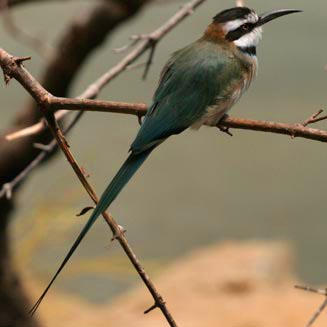|
Merops albicollis (White-throated
bee-eater)
Witkeelbyvreter [Afrikaans]; Witkeelbijeneter [Dutch];
Guêpier à gorge blanche [French]; Weißkehlspint [German];
Abelharuco-de-garganta-branca [Portuguese]
Life > Eukaryotes > Opisthokonta > Metazoa (animals) > Bilateria > Deuterostomia > Chordata > Craniata > Vertebrata (vertebrates) > Gnathostomata (jawed vertebrates) > Teleostomi (teleost fish) > Osteichthyes (bony fish) > Class: Sarcopterygii (lobe-finned fish) > Stegocephalia (terrestrial vertebrates) > Tetrapoda (four-legged vertebrates) > Reptiliomorpha > Amniota > Reptilia (reptiles) > Romeriida > Diapsida > Archosauromorpha > Archosauria > Dinosauria (dinosaurs) > Saurischia > Theropoda (bipedal predatory dinosaurs) > Coelurosauria > Maniraptora > Aves (birds) > Order: Coraciiformes > Family: Meropidae
 |
|
|
White-throated bee-eater, Bronx Zoo, New York, USA. [photo H.Robertson, Iziko
©] |
|
The White-throated bee-eater is a rare vagrant in southern
Africa, as it has only been recorded four times in the region, with sightings in KwaZulu-Natal, Western Cape (two separate records) and the Northern Cape. It
occurs in a band just below the Sahara Desert, from Mauritania to Ethiopia,
extending south to Tanzania, living mainly in semi-desert.
References
-
Hockey PAR, Dean WRJ and Ryan PG (eds) 2005. Roberts
- Birds of southern Africa, VIIth ed. The Trustees of the John Voelcker
Bird Book Fund, Cape Town.
|
